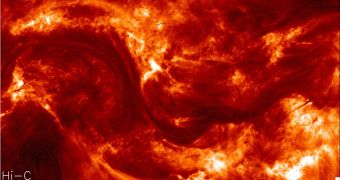Scientists at NASA obtained the highest-resolution image ever obtained of the solar corona, the extremely-hot upper layer of the Sun's atmosphere. The photo was collected using the NASA High Resolution Coronal Imager (Hi-C) telescope.
The instrument flew in space for a total of 620 seconds, after being launched on July 11, aboard one of the American space agency's 17.6-meter (58-foot) long sounding rockets. Takeoff occurred from the White Sands Missile Range in New Mexico.
Hi-C focused on the corona because this is one of the most mysterious layers of the solar atmosphere. Scientists still don't know why this layer is heated to millions of degrees, significantly hotter than the rest of the star. This mystery has been puzzling experts for decades.
The telescope was able to produce images in extreme ultraviolet wavelengths (EUV), at a resolution level of 1,086 kilometers (675 miles) per pixel. No other instrument was ever able to observe the corona in such fine detail.
Solar physicists plan to use the new data to gain a better understanding of the behavior displayed by the solar atmosphere, and also on how these activity patterns may influence space weather and our planet.
“These revolutionary images of the Sun demonstrate the key aspects of NASA's sounding rocket program, namely the training of the next generation of principal investigators, the development of new space technologies, and scientific advancements,” Barbara Giles explains.
She holds an appointment as the director of the NASA Heliophysics Division, at the space agency's Headquarters, in Washington DC. The expert adds that Hi-C weighed only 210.5kilograms (464 pounds), and that it was able to collect around 165 images during its 10-minute flight.
Some of the photos the telescope snapped revealed the dynamic structure of the Sun's atmosphere in exquisite detail. EUV is the perfect wavelength range to conduct such investigations.
“We have an exceptional instrument and launched at the right time. Because of the intense solar activity we're seeing right now, we were able to clearly focus on a sizeable, active sunspot and achieve our imaging goals,” says researcher Jonathan Cirtain.
He holds an appointment as a senior heliophysicist at the NASA Marshall Space Flight Center (MSFC) in Huntsville, Alabama. Cirtain concludes by saying that Hi-C was able to collect an image once every five seconds during its brief flight.

 14 DAY TRIAL //
14 DAY TRIAL //